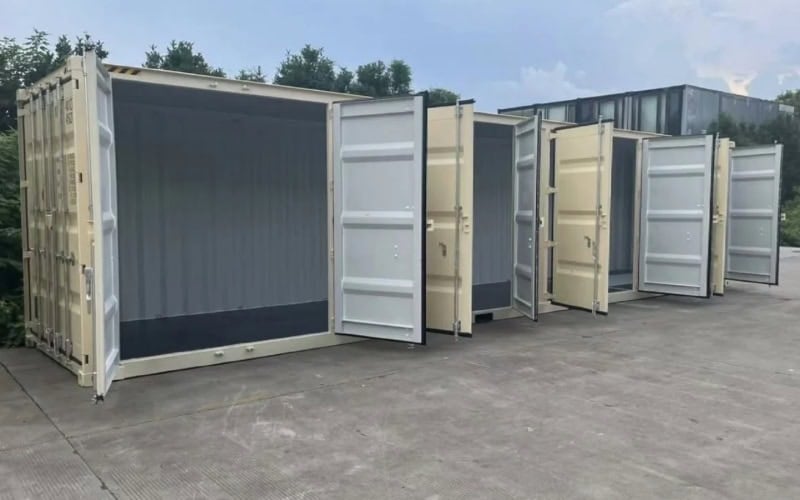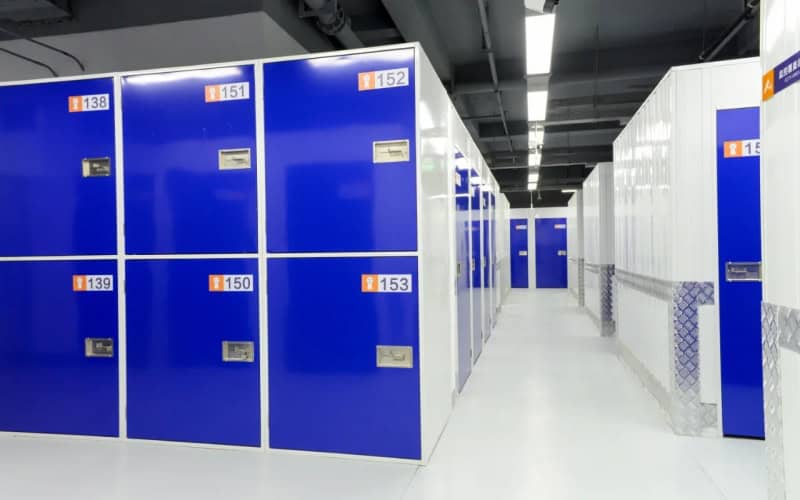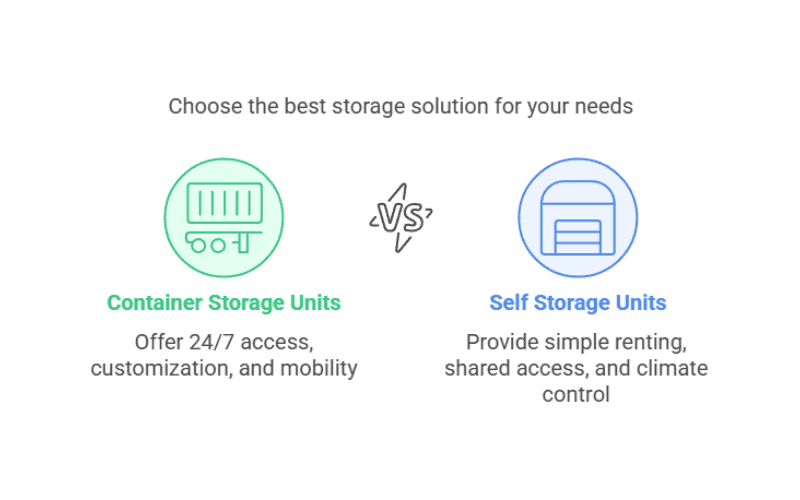If you’ve ever found yourself running out of space—whether at home, on a job site, or in your business—you’ve probably looked into renting a self storage unit or using a shipping container. But with so many options out there, it’s easy to wonder: which one actually makes more sense for your situation?
Maybe you’re tired of limited access hours at traditional storage facilities. Or maybe you’re looking for something more durable, flexible, and long-lasting than a monthly rental. We’ve worked with homeowners, contractors, small business owners, and storage companies who’ve asked the same questions—and made different choices based on their space, budget, and goals.
In this article, we’ll walk you through a detailed, side-by-side comparison of shipping container storage vs self storage units—sharing professional insights, real-world use cases, and practical solutions from our experience as a container building manufacturer.
What Is a Shipping Container Storage Unit?
A shipping container storage unit is a secure, weatherproof steel box you can place on your own property to store anything from tools to furniture—without relying on a storage facility.
Unlike freight containers, these units are custom-built or repurposed for storage, made from 1.6–2.0 mm thick corten steel with lockboxes and weatherproof seals for added protection. Common sizes include 10ft, 20ft, and 40ft lengths, all with a standard width of 8ft and a height of either 8.5ft (standard) or 9.5ft (high cube). We’ve seen homeowners use them during renovations, contractors store tools on job sites, and farmers protect feed or equipment. They’re wind- and water-tight, easy to move, and scale with your needs—just place another one when space runs out.

What Is a Self Storage Unit?
A self storage unit is a rented, enclosed space inside a larger facility—like having a garage in a warehouse. You pay monthly, choose from fixed sizes, and access your unit during the facility’s hours. Some offer climate control for sensitive items, but most require driving back and forth whenever you need something. It works well if you don’t have outdoor space and are okay with limited access.

We’ve seen many people pick self storage because it’s quick to rent and easy to use—some places give you a key the same day. You might also come across outdoor units or pods often called “self storage containers”, but they’re usually made of fiberglass or light metal, not built for harsh weather or long-term use. They’re fine short-term, but far less durable than steel units you place on your own land.
Side-by-Side Comparison: Container Storage Units vs Self Storage Units
Now that you’ve seen what each storage option is, let’s dive into how they stack up—because choosing the right solution isn’t just about space. It’s about how it fits into your daily life, budget, and plans for the future.

Cost Over Time: One-Time Payment vs Endless Rent
A self storage unit might look budget-friendly upfront, but those monthly fees pile up fast, especially if you’re paying for climate control or a larger space. After a year or two, you may be surprised how much you’ve spent.
With container storage units, you take on a higher upfront cost, but once it’s paid for, it’s yours—no ongoing rent. For long-term users, we often see that the break-even point lands between 18 and 24 months. After that, every month becomes pure savings. That’s why many small business owners and homeowners make the switch once they realize how often they access their stored items.
Accessibility: A Quick Scenario
Picture this:
It’s 7:45 PM. You remember something important you need from your storage. If your items are in a self storage unit, you’re either racing to beat the facility’s closing time—or waiting until tomorrow.
Now picture that same moment with a shipping container on your property. Walk outside, unlock the doors, and get what you need. No rush. No driving. No schedule.
Container storage = 24/7 control.
Self storage = dependent access.
Customization: Before and After
Before (Self Storage Unit):
You rent a generic box. No shelves. No lighting. No power. No permission to change anything.
After (Container Storage Unit):
You install racks. Add LED strips. Insulate the walls. Maybe even cut in a side door or window. You turn a steel box into a fully tailored, usable space.
As a shipping container storage manufacturer, we’ve helped clients pre-install all of these features before delivery—saving time and getting them up and running fast.
Mobility and Placement: Built to Move
You wouldn’t think of moving your self storage unit—it’s part of a permanent facility. But with a shipping container, moving it across your property or to a new job site is part of the design.
Example from experience:
A construction client rotated their container between multiple projects over the span of six months. One container. Multiple locations. Zero unpacking.
That kind of flexibility is hard to beat.
Durability: Designed for the Long Haul
Steel shipping containers are built for ocean freight—stacked, soaked, and beaten by weather—and they still hold up for decades. We’re talking corten steel, impact-resistant framing, and sealed doors that keep moisture out.
By contrast, most self storage units are housed indoors with thin metal walls, plywood dividers, or modular panel systems. They’re fine in controlled environments, but they’re not built to stand alone in extreme conditions.
To bridge that gap, we also offer self storage units made from converted shipping containers, combining the strength of corten steel with the convenience of traditional self storage. They’re a more durable, weather-resistant solution, and several storage operators have already chosen this model to upgrade their facilities.
Security and Privacy: Let’s Be Honest
Q: Who controls access to your storage?
Self Storage: You lock your unit—but it’s within a facility with shared access gates, camera monitoring, and staff oversight.
Container Storage: It’s on your land, locked by you, and nobody else has the key. You control visibility, access, and security features.
That peace of mind makes a real difference for people storing high-value tools, equipment, or personal items.
Permit and Zoning: A Little Planning Goes a Long Way
When it comes to permitting, self storage units have the advantage of simplicity—there’s no need to worry about land use, setbacks, or site prep. You rent the space, move your things in, and that’s it.
Shipping container storage does require a bit more planning. You may need to check local zoning rules, site clearance, or foundation requirements depending on where you live. But this is exactly where our experience comes in. As a container building manufacturer, we’re used to working through these steps. From designing for compliance to choosing the safest materials and advising on placement, we help clients secure approvals faster and with less hassle.
Quick Tip:
Not sure what your city allows? A short call to your local zoning office—or to our team—can save you time and headaches later.
Let your storage work for your lifestyle, not against it.
Are Shipping Containers Good for Storage?
After weighing the differences between container storage and self storage units, it’s clear each option serves a purpose—but many buyers still wonder: can a shipping container really protect my items long-term? The short answer is yes. And as container building specialists, we’ve seen just how reliable they can be—when built and modified the right way.
Not all storage needs are the same. Some users worry about moisture, others about temperature swings or structural wear over time. We’ve heard it all—from clients storing construction tools through winter, to someone keeping antique furniture safe in a rainy region. The good news? Shipping containers, especially those properly adapted for storage, are up to the task.
Real Use Cases of Shipping Container Storage
Built for Harsh Environments
Containers are designed to endure months at sea—wind, salt, rain, stacking pressure, you name it. When used on land, their performance is even more reliable. We’ve seen clients place containers in coastal zones, on farms, or directly at job sites—with zero structural issues even after years of use.
The steel walls and sealed doors naturally keep pests and water out, but additional upgrades can further improve storage conditions. Many customers add ventilation, insulation, or interior paneling to better match the local climate or the nature of what’s being stored.
Common Concerns About Container Storage—and Our Solutions
Let’s walk through some typical questions we get, and how they’re resolved in practice:
- Condensation:
Temperature shifts can cause moisture buildup, especially if the container is sealed tight. We usually recommend adding marine-grade vents or lining the ceiling with anti-condensation coating. Both are affordable and easy to install. - Temperature Control:
While containers aren’t naturally climate-controlled, they hold temperature well with basic insulation. For delicate goods, installing foam panels or a small ventilation fan can make a huge difference—especially in hot or humid areas. - Security:
The steel frame is already strong, but for added peace of mind, we often fit containers with lockboxes or reinforced doors to discourage tampering.
If you’re planning to store temperature-sensitive items, proper insulation is key. Here’s a practical guide on how to insulate a shipping container for better climate control and energy efficiency.
Long-Term Value and Minimal Maintenance
Once placed, a container storage unit requires very little upkeep. There’s no roof to patch, no wooden frame to rot, and no interior drywall to crack. We’ve seen clients leave them untouched for years—with zero maintenance beyond the occasional lock check or paint touch-up.
And when needs change, the container doesn’t become obsolete. Many users start with basic storage and later convert it into a workshop, office, or split-use unit. This flexibility adds long-term value well beyond typical storage.
Expandability and Modularity
Another advantage? You’re not locked into a fixed space. When your needs grow, adding another container beside or behind the first is simple. Units can be connected, stacked, or arranged in rows—even fitted with internal access doors.
This kind of modular growth is something we often help clients plan from day one. Whether it’s extra inventory, new tools, or just more room for personal items, shipping container storage can grow with you—literally.
While containers are incredibly versatile, not everything belongs inside. For safety and preservation, it’s important to know what not to store in shipping containers—from flammable materials to moisture-sensitive items.
Final Thoughts: Choosing the Best Storage Solution for Your Needs
By now, you’ve seen the strengths of both options—and the right choice depends on your situation.
- Choose container storage if you need long-term space, on-site access, customization, or mobility.
- Stick with self storage if you prefer a short-term rental, don’t have outdoor space, or need climate control from day one.
As a steel structure container building manufacturer, we don’t just provide solutions for shipping container storage—we also design and produce container-based self storage units. Whether you’re expanding a facility or starting a self storage business, using modified containers can give you an edge: greater durability, lower maintenance, and a stronger sense of security for your customers.

From fabrication to delivery, we support every stage of the process with custom design, built-in features, and site-specific guidance. If you’re ready to build a smarter, more resilient storage solution, our team is here to help turn that plan into reality.

